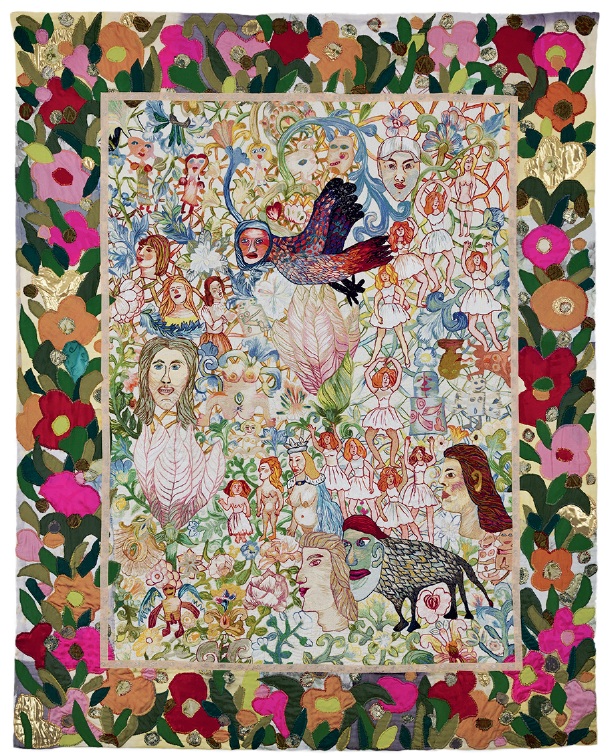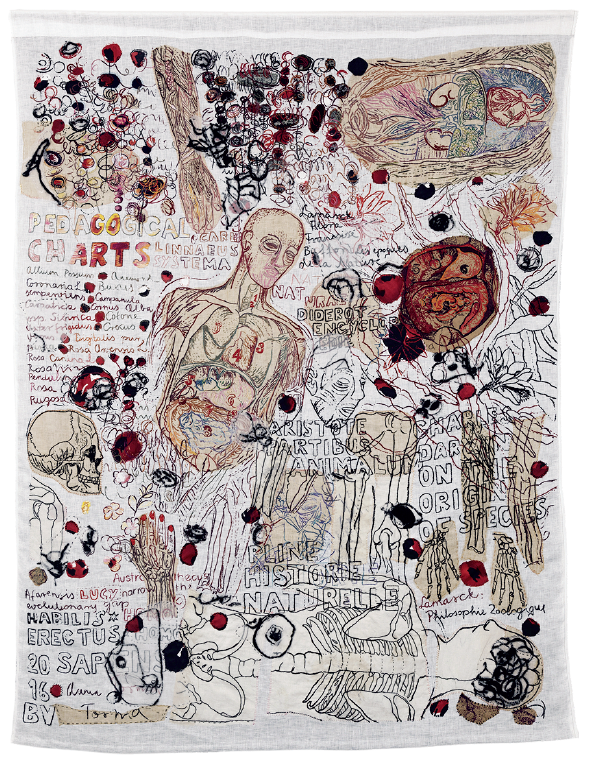Anna Torma
Bodies—faces and nudes, mostly female—stare straight at the viewer. It is a dense crowd depicted here, an intricate chaos. Images of pleasure, of carefree nudes, of winding vines and blazing orange-red flowers face off with monstrous figures: fire-breathing lizards and human faces on animal bodies. The piece is both Edenic and ominously phantasmagorical: monsters pose an underlying threat to what is otherwise utopian. These repeated animal and humanoid figures nearly form a language in themselves, a pictionary of anxieties and fears. There is a juxtaposition of unconscious terror with the ordinary, highlighted by scattered visual and textual “diary entries,” implying the tensions underlying daily life.

Anna Torma, Party with Dionysos, 2008–2015, hand-embroidered collage on linen fabric, cotton thread, silk collage border, 185 x 150 centimetres. Collection of Patrick Cady / Musée d’Art Contemporain Singulier. Photo: Guy L’Heureux. Courtesy Galerie Laroche/ Joncas, Montréal.
The textile work I’m referring to is Permanent Danger, 2017, displayed like a scroll and centrally installed on an opening between the galleries. Both sides of the piece form picture planes through a technique known as double-sided embroidery. Anna Torma’s crafting leaves viewers in awe. Embroidery, her primary medium for decades, was passed down in her family as a traditional Hungarian craft. The dense detailing in Permanent Danger and in other works in the exhibition results from a thick piling of thread, lending a painterly appearance, while the nervous, animated line appearing alongside has the spontaneity of quick sketching. Over the years, Torma has expanded a traditional skill and, through research and travel, has assembled her own textile collection, which serves either as backdrop or as collage elements. It is comprised of linen, cotton and synthetic fabric, including a sundry of found material, such as textile strips, doilies and Hungarian embroidery.
“Permanent Danger” is this exhibition’s title and relates thematically to other works—Permanent Danger 4, 2019; Permanent Danger 5, 2019; Fight 1, 2018; and Fight 2, 2018— in depicting a sense of threatened violence. Still, danger is not the overall theme. This sprawling exhibition carries a range of other subthemes, both intertwining and discrete, including family, identity, sexuality, Dionysian pleasure and a playful critique of scientific rationalism. This presentation of her recent work from 2011 to the present is timely, given the recent attention granted to this New Brunswick-based, Hungarian-Canadian textile artist, who is the winner of the 2020 Governor General’s Award in Visual and Media Art.
While Torma may be gaining national recognition, in part because of recent turns to feminism and figurative art, her work is refreshingly individualistic; she has held a stable course throughout her practice history. Torma’s work is notable, as well, for taking embroidery from the Victorian parlour of traditional women’s work and the stereotypes of modesty associated with it and countering these stereotypes with bold sexuality. An example is Dionysia, 2020, one of a pair of related works (the other is Party with Dionysos, 2008–2015). A lush setting brims with decadence— a paradisical backdrop of flowers and vines houses a young sailor, a smiling devil’s head, an amphibious monster and two women performing fellatio on a disembodied giant phallus dripping semen. They form a carnal carnival recalling Bosch more readily than traditional embroidery designs.

Pedagogical Charts 1, 2016, hand-embroidered collage on linen fabric, silk thread, 143 x 116 centimetres. Collection of Michel L’Heureux. Photo: Guy L’Heureux.
Adding to Torma’s call for pleasure is a playful critique of the rational, especially the biological, to favour, or at least not forget, the subjective in Pedagogical Charts 1 and 2, 2016. Pedagogical Charts 1 centres on allusions to the biological and philosophical. Anatomical drawings, cross-sections of internal organs, human skulls and skeletal hands appear throughout the composition. Additionally, Torma alludes to the intellectual rationalism of science rooted in the Age of Reason through textual references to Diderot, Darwin’s Origin of Species and Lamarck’s Philosophie zoologique. Alternative references in Pedagogical Charts 2 are to Torma’s family and their lives: their written names and miscellaneous, sometimes unexplained, notes such as “Spin Gallery” and “Spring is Coming” concerning events, places and observations. Philosophy and the material reality of the body pair with connections to family in an intertwining of the rational and the subjective, the detached and the personal, the self-constructed and the biological.
Amidst current divisive political and cultural wars, Torma proposes a collage, if not a merger, of opposites forming the totality, not the polarities, of life. Expanding the field of embroidery from the domestic to the philosophical and the sexual, Torma’s art is a thoughtful meditation on the pleasures of daily life, family and identity. Without self-censoring or otherwise avoiding what is threatening or disturbing, it is frank and joyful. ❚
“Permanent Danger” was exhibited at the Textile Museum of Canada, Toronto, from August 5, 2020, to March 21, 2021.
Earl Miller is an independent art writer residing in Toronto.

